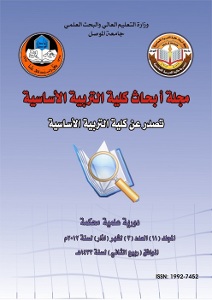The meaning of (as if) in the simile in the Holy Quran
Abstract
(Simile image) in Holy Qur’an is: what a simile generates when it comes in suggestive artistic ways that form an image with dimensions and an effective statement.
It is based on two pillars: pronunciation and meaning, or form and content when united through strengthening and clarifying relationships. There is no doubt that (similey image) in Holy Qur’an was suggestive and expressive that expressed meaning perfectly.
Simile tool (as if) came to perform its function through its combination of (kaf) and (an), so simile (with kaf) came together with emphasis with (if), suggesting a strong cohesion between similar and the one being suspected. Therefore, when resemblance becomes strong, tool (as if) is used. Without anything else, just as Queen of Sheba said (as if he is him), and if she had said: (he is like this) it would not have been (the simile) as stated in revelation.
References
- Bahr Al-Ulum, Abu Al-Layth Nasr bin Muhammad bin Ahmed bin Ibrahim Al-Samarqandi, the Hanafi jurist (373 AH), Dar Al-Fikr - Beirut, edited by: Mahmoud Mutaribi, d: i, d: d.
- The Long Sea in the Interpretation of the Glorious Qur’an, Abu Al-Abbas Ahmed bin Muhammad bin Ajiba Al-Fassi, (1224 AH), edited by: Ahmed Abdullah Al-Qurashi Raslan, publisher: Dr. Hassan Abbas Zaki Cairo, Dr. I, 1419 AH.
- Arabic Rhetoric (its foundations, sciences, and arts), Abdul Rahman Hassan Habankah Al-Maidani, Dar Al-Qalam, Damascus, third edition, 1431 AH - 2010 AD.
- Al-Bayan in the Light of the Methods of the Qur’an, Abdel Fattah Lashin, Dar Al-Maaref, first edition, Cairo, 1977 AD.
- Al-Tibyaan fi Al-Bayan, Sharaf Al-Din Al-Tibi (743 AH), edited by: Tawfiq Al-Fail, Abdul Latif Lutfullah, Dhat Al-Sasil Press, Kuwait, first edition, 1406 AH - 1986 AD.
- Liberation and Enlightenment, Muhammad Al-Tahir bin Ashour (1393 AH), Tunisian Publishing House, Tunisia, 1984.
- Interpretation of the Mighty Qur’an, Muhammad bin Abdullah Al-Alberi Al-Ma’ruf bin Abi Zamanin Abu Abdullah Al-Maliki (399 AH), edited by Abu Abdullah Hussein Okasha - Muhammad bin Mustafa Al-Kanz, Dar Al-Farouk Al-Hadithah, Egypt - Cairo, first edition, 1423 AH - 2002 AD.
- Al-Jami’ Al-Kabir - Sunan Al-Tirmidhi - Muhammad bin Issa Al-Tirmidhi (279 AH), edited by: Bashar Awad Ma’rouf, Dar Al-Gharb Al-Islamiyyin, Beirut, 1998 AD.
- Jamharat al-Lughah, Abu Bakr Muhammad bin al-Hasan bin Duraid al-Azdi (321 AH), edited by: Ramzi Munir Baalbaki, Dar al-Ilm Lil-Millain, Beirut, first edition, 1987 AD.
- Ruh al-Bayan, Ismail Haqqi al-Istanbouli al-Hanafi al-Khalouti (1127 AH), Dar al-Fikr, Beirut, d. i, d. T.
- The Spirit of Meanings in the Interpretation of the Great Qur’an and the Seven Mathanis, Abu al-Thana Shihab al-Din Mahmoud al-Alusi (1270 AH), edited by: Ali Abd al-Bari Atiya, Dar al-Kutub al-Ilmiyyah, Beirut, first edition, 1415 AH.
- Sunan al-Tirmidhi, Muhammad bin Issa al-Tirmidhi (279 AH), edited by: Ahmed Muhammad Shaker, Muhammad Fouad Abdel-Baqi, and Ibrahim Atwa Awad, Mustafa al-Babi Press, Egypt, second edition, 1395 AH, 1975 AD.
- Explanations of Al-Talkhis, Al-Qazwini (739 AH) and others, Issa Al-Babi Al-Halabi. D. i, d. T.
- The Artistic Image in the Qur’anic Proverb, Muhammad Hussein Al-Saghir, Dar Al-Rashid, Iraq, 1981, d. i.
- Sciences of Rhetoric, Al-Bayan, Al-Ma’ani and Al-Badi’, Ahmed Mustafa Al-Maraghi, Dar Al-Kutub Al-Ilmiyyah, Beirut, Lebanon, Dr. i, d. T.
- Strange of the Qur’an, Ibn Qutaybah Al-Dinouri: (276 AH), edited by: Saeed Al-Lahham, Dr. i, d. T.
- Fath al-Bayan fi Maqasid al-Qur’an, Abu al-Tayyib Siddiq al-Qanuji (1307 AH), edited by: Abdul Razzaq al-Mahdi, Dar al-Kitab al-Arabi, Beirut, Lebanon, 1429 AH - 2008 AD, Dr. i.
- Divine Conquests and Unseen Keys, Nimatullah bin Mahmoud Al-Nakhjawani (920 AH), Rakabi Publishing House, Al-Ghuriya - Egypt, first edition, 1419 AH - 1999 AD.
- The Qur’an and the Graphic Image, Abdul Qadir Hussein, World of Books, Beirut, second edition, 1985.
- Al-Kashaf, Abu Al-Qasim Mahmoud bin Amr bin Ahmed Al-Zamakhshari Jar Allah (538 AH), Dar Al-Kitab Al-Arabi, Beirut, third edition, 1407 AH.
- The Chapter on Interpretation in the Meanings of Revelation, Aladdin Ali bin Muhammad Abu Al-Hasan, known as Al-Khazen (741 AH), Dar Al-Kutub Al-Ilmiyyah, Beirut, first edition, 1415 AH.
- Lisan al-Arab, Ibn Manzur (711 AH), edited by Abdullah Ali al-Kabir, Muhammad Ahmad Hasb Allah, and Hashem Muhammad al-Shazly, Dar al-Ma’aref, Cairo, Dr. i. D. T.
- Lataif Al-Isharat - Tafsir Al-Qushayri -, Abdul Karim bin Hawazin Al-Qushayri (465 AH), edited by: Ibrahim Al-Basiouni, Egyptian General Book Authority, Egypt, third edition, Dr. T.
- Metaphor of the Qur’an, Abu Ubaida, Muhammad bin Al-Muthanna Al-Taymi Al-Basri (209 AH), edited by: Muhammad Fouad Sezgin, Al-Khafaji Library, Cairo, Dr. I, 1381 AH.
- The brief editor in the interpretation of the Holy Book, Abu Muhammad Abd al-Haqq bin Ghalib bin Atiya al-Andalusi (542 AH), edited by: Abd al-Salam Abd al-Shafi, Dar al-Kutub al-Ilmiyyah, Beirut, first edition, 1422 AH.
- Al-Misbah Al-Munir fi Ghareeb Al-Sharh Al-Kabir by Al-Rafi’i, Ahmed bin Muhammad bin Ali Al-Maqri Al-Fayoumi (770 AH), Ministry of Education, eighth edition, Cairo, Al-Amiriya Press in Bulaq, 1939.
- Meanings of the Qur’an and its parsing, Ibrahim bin Al-Sari bin Sahl Abu Ishaq Al-Zajjaj (311 AH), World of Books, Beirut, first edition, 1408 AH - 1988 AD.
- Vocabulary of the Words of the Qur’an, Al-Raghib Al-Isfahani, edited by Safwan Adnan Daoudi, Dar Al-Qalam, fourth edition, 2009.
- Al-Mufassal fi Sanaat al-Zamakhshari, Jarallah Mahmoud Al-Zamakhshari, Dr. i, d. T.
- Nashm al-Durar fi Tanasab al-Ayat and Surahs, Ibrahim bin Omar bin Abi Bakr al-Baqa’i (885 AH), Dar al-Kitab al-Islami, Cairo, Dr. i, d. T.






